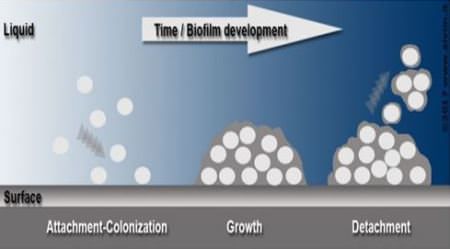Detection of Bacterial Growth and Biofilm Formation in Pipelines Made Easy
Published on by Giovanni Pavanello, Director at ALVIM Biofilm Monitoring Technologies in Academic
On the surfaces that are in contact with water, a “biofilm” layer of microorganisms that are contained in a matrix (slime layer) can be formed.
It is as a complex community of microorganisms, embedded in self-created extracellular polymeric substances (EPS).
The biofilm is a microbial population adherent to each other and to the surfaces or interfaces enclosed in the matrix. Their presence in manufacturing pipelines can be responsible for a wide range of water quality and operational problems.

A Biofilm layer can form on any surface, even in extreme conditions (e.g., very high and very low pH values and temperature, in radioactive waters, even in space stations), and it causes a variety of problems:
Increase in the risk of pathogens – biofilm is the ideal environment for the proliferation of harmful bacteria by offering shelter and food;Decrease in thermal efficiency of heat exchangers – for example, the biofilm is more insulating than calcium carbonate;Microbiologically influenced corrosion (MIC) – also known as bacterial corrosion, it accounts for billions of dollars of industrial damages all over the world.
Large amounts of chemical substances (sanitizers, biocides, and disinfectants) are usually employed to prevent biofilm development in industrial piping systems. However, often they do not provide the expected results. In most cases, Clean-In-Place (CIP) and sanitation treatments are applied out on a regular basis (daily, or weekly) or when visible problems arise.
The real need for neither the treatment nor its effectiveness is verified.
It is important to note that it is usually hard to take representative samples (“swabs”) from internal pipe surfaces. Standard plate counts applied to water samples are of limited use. Indeed, it is well known that bacterial growth on pipe surfaces is mostly unrelated to the presence/number of bacteria in the water. Planktonic (free-floating) bacteria attach to the pipes by the production of ESP; they multiply and form a mature biofilm, stabilizing the microcolony from environmental stress.
Therefore, most bacteria live in biofilms, not free in the water.
Read full article: BioExpert
Media
Taxonomy
- Food Security
- Bacteria
- Food Processing
- Biofilm Monitoring Systems
- Biofilm Sensors